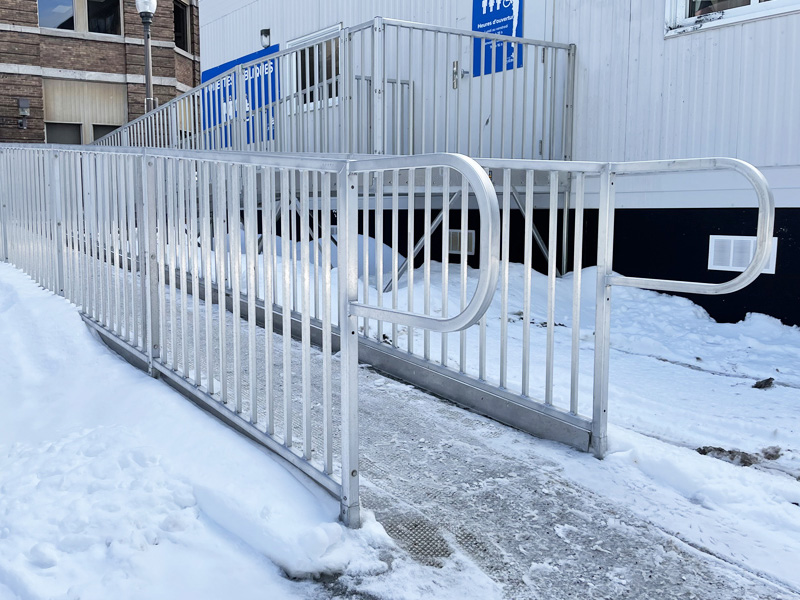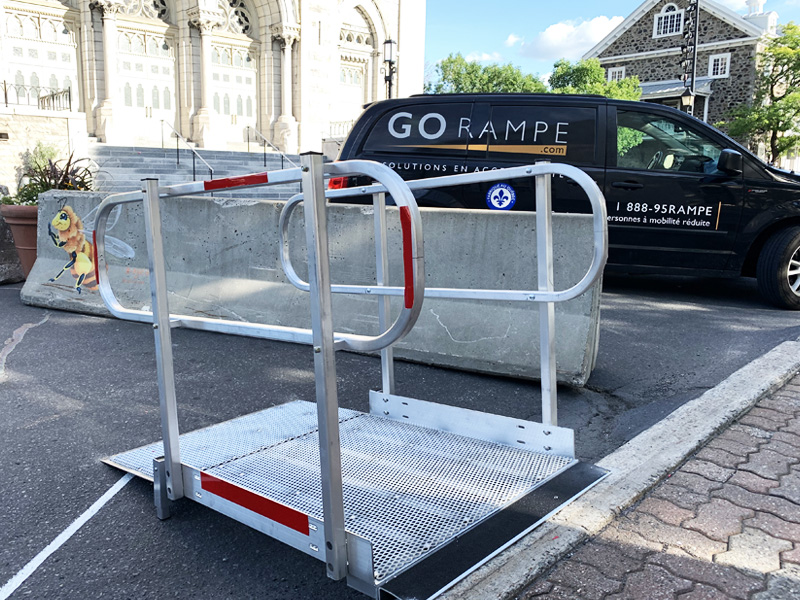Click on our tabs to discover our different accessibility solutions.
Access Ramp FAQ
Cost and Funding for an access ramp

Yes, all access ramps for people of reduced mobility or the disabled are taxable; however, portable ramps are not.
Yes, a federal-provincial tax credit of 32.52% is granted for the installation of any model of ramp.
Wood is generally the most affordable material. However, it can be particularly slippery when wet so it’s not very safe. Also, it tends to rot with time so it has to be replaced, on average, every ten years. Access ramps made of galvanised steel or of concrete are considerably more expensive than those made of aluminum (15% more for galvanised steel and 25% more for concrete). Aluminum access ramps are known for being robust, weather resistant, and durable. In addition, aluminum requires no maintenance. All in all, with aluminum you get better value for your money.
Access ramp installation

Absolutely! Go rampe offers installation services, even in winter. Since there is no need dig up the ground to install our ramps, it’s enough just to clear the snow from the area of the feet of the ramp, and it’s done.
No problem! We adapt the path of the ramp to any obstacle in the vicinity of your entrance.
The purpose of the lower handrail is to allow support within reach of a person in a wheelchair.
Our ramps rest directly on the ground. Because the feet of the ramps are vertically adjustable, they can easily conform to uneven terrain or any ground shift caused by seasonal temperature changes.
Not at all. Our ramps are self-supporting, which means that they don’t require any digging, piles, or concrete. When you move, all you need to do is dismantle your ramp, and reinstall it at your new home. It will not leave any trace on your previous property.
Materials and colors

Absolutely! We carry a broad spectrum of colors in our line of powder paints. It is therefore very possible to match the color of your ramp to your door and window frames. Bear in mind that this entails additional costs.
No problem! For example, we could make a wooden ramp to match the style of your house, with an aluminum floor surface for safety.
Without a doubt, open-mesh aluminum flooring is by far the best and safest. The open mesh prevents any pooling of water and, consequently, any accumulation of ice, thus ensuring an anti-slip surface.
Technical and legal considerations

The code stipulates a maximum rate of inclination of 1 :12 (for every inch of height, there must be 12 inches of ramp length). For example, if the height of the ramp is equal to a stairway of three steps (21 inches in height), the length of the ramp must be 21 feet.
The platforms must be 5’ x 5’ (that is, 1500mm x 1500mm).
A straight section can be a maximum of 9 meters, or 30 feet. At this point, a horizontal resting platform must be installed before continuing with the next inclined section.
In its building code, the Régie du bâtiment du Québec recommends a height of between 34” and 36”.
According to the building code as per the Régie du bâtiment du Québec, 36 inches is the minimum required width.
It is mandatory whenever there is any structural elevation, be it a step, a doorway sill, etc., that is between 1 and 75 inches in height.
The building code requires an access ramp in the event that the entrance, or any point of access to the building, is 13mm or more from ground level. If the building is situated on inclined terrain, we recommend that you consult the Régie du bâtiment du Québec to inquire about the regulations concerning the installation of an access ramp for people of reduced mobility.
No, you are not legally required to install a ramp. However, if you do decide to install an access ramp, you could benefit from a government subsidy to help you with the cost. If you would like more information, you can consult the Société d’habitation du Québec website below: